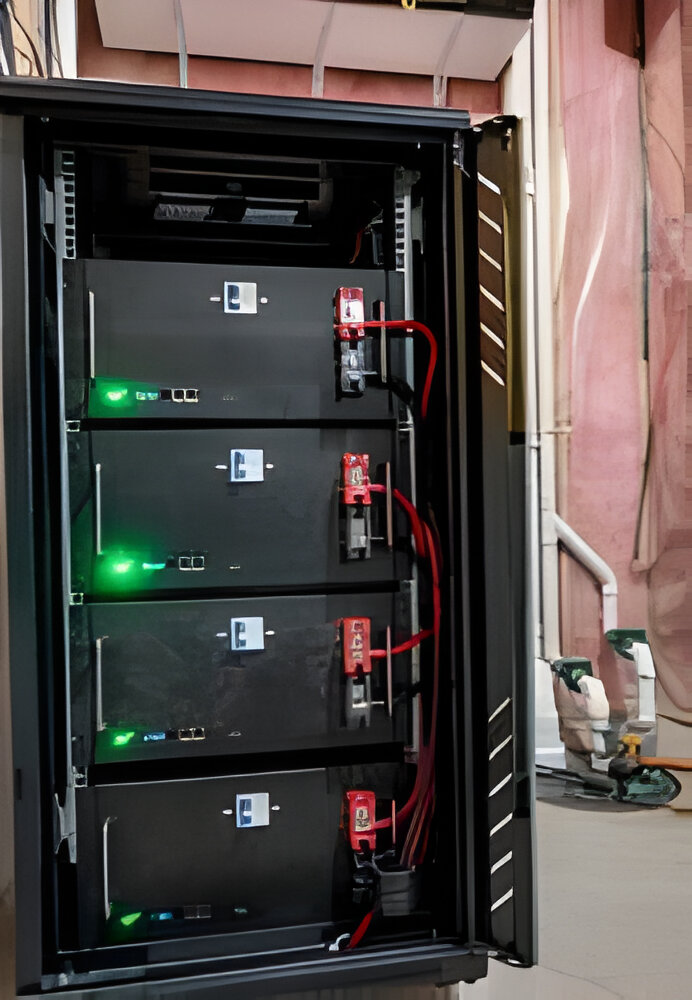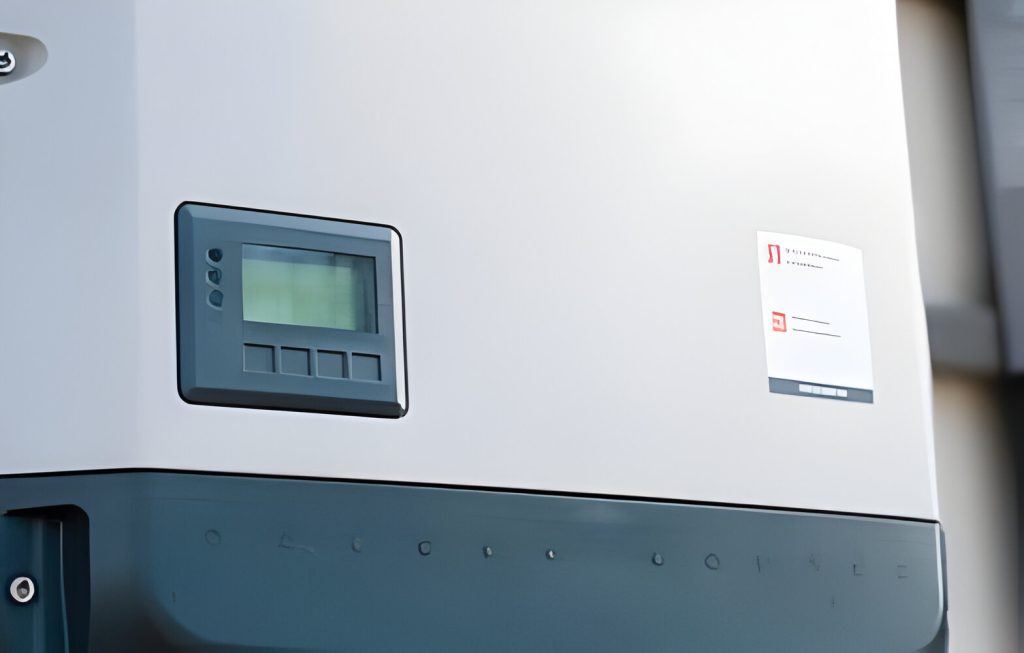Home battery backup systems provide power during outages without needing solar panels. They offer energy independence and reliability.
Homeowners seeking to safeguard their residences from power interruptions now have robust solutions. Home battery backups can be a game-changer, especially in areas prone to blackouts or severe weather. These systems store electricity from the grid and make it available during a power cut, ensuring critical appliances remain operational.
With a variety of options on the market, consumers can choose a system tailored to their specific energy needs and consumption patterns. This ensures a continuous power supply and peace of mind, even without renewable energy sources like solar. Families can enjoy uninterrupted power access by integrating a home battery backup, come rain or shine.

The Rise Of Home Battery Backup Systems
Home battery backup systems are gaining momentum.
With unpredictable weather and an unreliable grid, homeowners seek constant power.
These systems provide energy independence and peace of mind.
Reasons For Increased Interest
The demand for home battery backups is on the rise. Here’s why:
- Climate Change: Severe weather leads to more power outages.
- Energy Costs: Batteries save money during peak rates.
- Emergency Preparedness: They offer a reliable power source.
Comparing Solar And Non-solar Options
Let’s look at the differences between solar and non-solar battery backups.
| Solar Battery Backup | Non-Solar Battery Backup |
|---|---|
| Uses solar panels | Charges from the grid |
| Higher initial cost | More affordable start |
| Lower utility bills | Grid-dependent costs |
Both options ensure backup power. The choice depends on preference and budget.
Home Battery Backup Without Solar
Investing in a system that ensures your home remains powered during outages is becoming increasingly popular among homeowners. These systems store electricity, which can be drawn upon when the primary grid is down, guaranteeing that essential appliances and lights continue functioning. This provides peace of mind and offers a layer of security and convenience, especially in areas prone to power interruptions. Moreover, pairing such systems with renewable energy sources like solar panels for those looking to reduce their carbon footprint can further minimize reliance on traditional power grids and foster a more sustainable lifestyle.

Credit: naturesgenerator.com
Understanding Home Battery Backup Basics
Understanding Home Battery Backup Basics is critical to ensuring uninterrupted power in your home, even without solar panels. Let’s explore how a home battery system can keep the lights on during outages.
How Home Battery Systems Work
Think of a home battery backup system like a power bank for your house. It stores electricity from the grid and provides it when needed. The system kicks in during power cuts, keeping your appliances running smoothly.
- Charges during off-peak: The battery charges when electricity costs are low.
- Automatic switching: It automatically turns on during an outage.
- Quiet and clean: These systems operate silently and produce no emissions.
Critical Components Of Battery Backup
The heart of a battery backup system lies in its components. Each part plays a crucial role.
| Component | Function |
|---|---|
| Battery | Stores energy for later use. |
| Inverter | Converts stored energy to usable power. |
| Charge Controller | Manages battery charge and health. |
| Management System | Oversees the entire operation. |
Together, these components ensure your home remains powered during unexpected blackouts. With a well-designed battery backup, peace of mind is a switch away.
Evaluating Your Power Needs
When the power goes out, having a home battery backup can be a lifesaver. It’s essential to know how much energy you need during an outage. This guide helps you evaluate your power requirements and choose the right backup solution.
Assessing Energy Consumption
Start by listing devices you’ll need during a power outage. Include essentials like the fridge, lights, and phone chargers. Don’t forget about comfort items like fans or heating systems.
- Check your utility bill for average energy usage.
- Use energy monitors to track individual appliances.
- Note the wattage on appliance labels.
Calculating Backup Power Requirements
Once you know what devices you’ll use, it’s time to calculate the total power needed. This ensures your backup system won’t fall short.
- Add up the wattage of all devices.
- Estimate how long each device will run daily.
- Multiply wattage by hours to get watt-hours (Wh).
Consider a buffer of 20% more power to be safe.
More rows as needed
| Device | Wattage | Hours Used | Total Wh |
|---|---|---|---|
| Fridge | 150 | 24 | 3600 |
With these steps, you’ll clearly understand your home’s power needs. This prepares you to select the proper battery backup without solar.

Types Of Non-solar Batteries
Exploring the Different Types of Non-Solar Batteries offers a deep dive into the options available for home battery backup systems that do not require solar panels. Understanding these options ensures the right choice for your power needs.
Lead-acid Vs. Lithium-ion
Two popular types of non-solar batteries are Lead-Acid and Lithium-Ion. Each has unique benefits and drawbacks.
- Lead-acid batteries are cost-effective and have a robust track record in energy storage. Yet, they are heavier and have a shorter lifespan.
- Lithium-ion batteries are known for their longevity and efficiency. They are lighter but cost more upfront.
| Battery Type | Cost | Weight | Lifespan |
|---|---|---|---|
| Lead-Acid | Lower | Heavy | Shorter |
| Lithium-Ion | Higher | Light | Longer |
Alternative Battery Technologies
Aside from the traditional options, several alternative battery technologies exist.
- Nickel-Cadmium (NiCd): Effective in cold climates, robust, but less eco-friendly.
- Saltwater Batteries: An eco-friendly choice, free from heavy metals, with moderate efficiency.
- Flow Batteries: They excel in longevity and scalability but require more space and complex setup.
Each technology serves different needs and spaces. Choosing the right one depends on specific requirements and environmental considerations.
Installation And Maintenance
Understanding the nuances of home battery backup installation and maintenance is crucial for a seamless experience. The process can vary greatly depending on whether you choose a professional installation or a DIY approach. Proper maintenance ensures longevity and efficiency. Let’s explore the best practices for installing and maintaining your home battery backup system.
Professional Vs. Diy Installation
Professional installation often comes with expert advice and guaranteed safety. Technicians bring the right tools and knowledge to your doorstep. They ensure your system integrates perfectly with your home’s electrical setup. On the other hand, DIY installation can be tempting. It might save money upfront. But it requires a solid understanding of electrical systems. It also demands strict adherence to safety protocols. Consider your skill level and the complexity of the system before deciding.
| Installation Type | Pros | Cons |
|---|---|---|
| Professional | Expertise, safety, time-saving | Higher initial cost |
| DIY | Cost-effective, self-accomplishment | Riskier, requires technical knowledge |
Routine Maintenance Tips
Regular upkeep is key to a reliable home battery backup system. Check your system’s health periodically. Look for any warning signs on the display panel. Clean the battery terminals to prevent corrosion. Ensure the area around the battery is clutter-free to allow proper ventilation.
- Inspect battery terminals monthly for tightness and cleanliness.
- Verify that the system software is up to date.
- Test the system’s load capacity yearly to confirm performance.
- Make sure the vicinity of the battery is dry and clean.
Refer to the manufacturer’s guide for specific maintenance requirements. Adhering to these routines will extend the life of your home battery backup. It will also ensure it operates at peak performance when needed.

Credit: www.energyshieldnh.com
Cost Analysis And Incentives
Understanding the financial side of home battery backup systems is crucial. Homeowners often ponder the cost and available incentives. Let’s break down the expenses and potential savings, plus explore government incentives.
Upfront Costs And Long-term Savings
Investing in a home battery backup system involves initial costs. These include the battery unit, installation, and any additional equipment. Prices can range significantly based on battery capacity and brand.
- Small-scale units: $3,000 – $7,000
- Mid-range systems: $7,000 – $14,000
- Large-scale solutions: $14,000+
Long-term savings come from avoiding peak electricity rates and having power during outages. Homeowners may save on monthly energy bills. Maintenance costs are low, increasing overall savings.
| Year | Savings |
|---|---|
| 1-5 | $500 – $1,000 |
| 6-10 | $1,000 – $2,000 |
| 10+ | $2,000+ |
Government Rebates And Tax Credits
Government incentives can reduce the initial investment in battery backup systems. These incentives include rebates and tax credits, varying by location and policy changes.
- Research local rebates: Some regions offer cash rebates for installing battery storage.
- Investigate federal tax credits: Up to 26% of the system cost may be claimed.
- Check for state incentives: States like California provide additional rebates through programs like SGIP.
These incentives help lower the barrier to entry for homeowners. They make home battery backup systems more accessible and affordable.
Integration With Existing Home Systems
Exploring the integration of home battery backup systems without solar with existing home setups is crucial. This ensures seamless operation and enhances overall home efficiency.
Compatibility With Generators
Home battery backups can work well with generators. This dual setup allows for extended backup power during outages. Key points include:
- Automatic synchronization ensures the battery and generator work together smoothly.
- Batteries can charge from the generator during prolonged blackouts.
- The setup minimizes fuel consumption and reduces generator wear.
This integration helps maintain power without interruption.
Smart Home Integration
Smart home systems can integrate with battery backups. This innovative integration allows for the following:
- Control of battery settings from smart devices.
- Automated management of power distribution based on priority.
- Real-time monitoring and adjustments via apps.
This setup ensures optimal performance and convenience.
Both setups provide robust solutions for maintaining power and managing resources effectively within modern homes.
Safety And Regulations
Ensuring safety with home battery backups is crucial. It protects homes and families. Regulations guide these safety measures. They vary by location. Homeowners must understand and follow them. This section dives into safety standards and navigating local regulations.
Understanding Safety Standards
Home battery backups must meet safety standards. These standards prevent accidents and ensure reliable operation. They cover battery design, installation, and maintenance.
- Certifications like UL 9540 assure product safety.
- Thermal management systems keep batteries at safe temperatures.
- Enclosures protect against physical damage and weather.
Manufacturers test batteries rigorously. They ensure batteries can withstand various conditions without failing.
Navigating Local Regulations
Local regulations can be complex. Homeowners must understand them before installing a battery system.
- Check with local building departments for specific requirements.
- Secure necessary permits before installation.
- Follow zoning laws that may affect where you can place your battery.
- Ensure installation by a certified electrician.
Compliance with local regulations keeps communities safe. It also prevents legal issues for homeowners.

Real-life Use Cases
Understanding home battery backup systems goes beyond their features and specifications. Real-life use cases highlight the practical benefits these systems offer. They provide peace of mind during power outages and enhance daily energy reliability. Let’s dive into stories and experiences that showcase their impact.
Emergency Preparedness Stories
Power outages can happen anytime, often without warning. Home battery backups prove invaluable during these times. Here are compelling anecdotes from individuals who have benefited from these systems:
- Storm Resilience: In coastal areas, a family kept their lights on and fridge running during a hurricane, thanks to their home battery backup.
- Medical Equipment: A user with a home-based dialysis machine maintained his treatment schedule during a blackout, all due to his reliable battery system.
- Work Continuity: A remote worker never missed a deadline, even when her entire block lost power. Her home battery backup kept her devices charged and her internet connection stable.
Day-to-day Reliability Experiences
Beyond emergencies, home battery backups support daily life. Users enjoy uninterrupted power for various needs:
| Use Case | User Experience |
|---|---|
| Evening Activities: | One family enjoys movie nights without fear of power flickers disrupting their fun. |
| Home Projects: | A DIY enthusiast uses power tools in his backyard shed, independent of the primary grid. |
| Energy Savings: | Households lower their energy bills by using stored power during peak rate hours. |
Future Trends In Home Battery Backup
Home battery backup systems evolve rapidly as the demand for energy independence grows. These systems ensure a continuous power supply during outages, providing peace of mind and increased home efficiency. With technology advancing, the future of home battery backup looks brighter than ever.
Innovations On The Horizon
Leading tech companies are developing cutting-edge batteries with longer lifespans and larger capacities. These innovations promise to make home battery backup systems more robust and reliable.
- Solid-state batteries: Offer higher energy density.
- Modular designs: Allow easy expansion of storage capacity.
- Intelligent software integration: Enables efficient energy management.
The Role Of Battery Backup In Grid Stability
Home battery backups play a crucial role in maintaining grid stability. They store excess energy during low demand and supply it during peak times.
| Benefits | Impact on Grid |
|---|---|
| Peak Shaving | Reduces stress on the grid. |
| Load Balancing | Prevents power outages. |
| Renewable Integration | Supports clean energy use. |
These systems support individual homes and contribute to a more resilient power infrastructure.

Credit: www.anker.com
Frequently Asked Questions
Can I Have Battery Backup Without Solar Panels?
Yes, using other charging methods, such as the electrical grid or generators, you can have a battery backup system without solar panels.
How Much Is A Powerwall Without Solar?
A Tesla Powerwall costs approximately $11,000 to $12,000 without solar panels, including installation.
Are Home Battery Backups Worth It?
Home battery backups can be a valuable investment, providing power during outages and reducing reliance on the grid, especially for areas with frequent power disruptions or high electricity rates.
Is There A Battery That Can Power A House?
Yes, some batteries can power a house. Tesla Powerwall and LG Chem are popular options. They store solar energy or electricity from the grid to provide backup power during outages.
Conclusion
Exploring home battery backup systems offers a reliable power solution independent of solar energy. These systems ensure safety during outages and reduce reliance on the grid. This is an effective alternative for households not ready to invest in solar panels.
Consider your specific needs and choose a system that offers peace of mind and energy security.

I am a battery specialist writer and blogger based in the USA & UK . I have been working with battery power energy for 3 long years and I give trips on low battery power problem and solutions . I have a lot of experience with battery power and I share them here.

